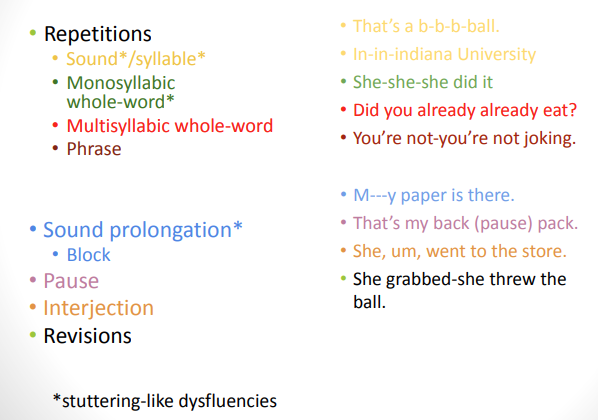Fluency Disorders
1/16
There's no tags or description
Looks like no tags are added yet.
Name | Mastery | Learn | Test | Matching | Spaced |
|---|
No study sessions yet.
17 Terms
• Fluent speech is:
Effortless • Easy • Rhythmical • Evenly flowing
• Dysfluent speech is marked by:
• Interrupted flow of speech • Mental and physical effort to continue • May result in negative perceptions of self
Prevalence/Incidence
• Affects all races, cultures, socioeconomic classes, cognitive abilities • Reported prevalence 1% in US (4% in school age, likely higher in preschool) • Incidence of ~5% • males > females (4:1) • High degree of familial incidence
Causes
• Exact cause unknown; many theories • IT IS NOT • Tied to intellect • Nervous reaction • Result of parenting styles • Possible genetic link as it does run in families
NeurophysiologA few Theories of Stutteringical/Organic
Neurophysiological/Organic
Prior theories of a defective tongue
• The importance of updating research (Dieffenbach)
Laryngeal dysfunction
• Laryngeal muscles too tense, abductors and adductors working at the same time
The Brain
• Very limited evidence (speech coordination, hemispheric dominance)
Impaired Auditory Mechanism
• Delayed auditory feedback
• Is it the masking noise or is it do to decreased speech rate?
Stuttering and Environmental Factors
Anticipation struggle theory
• Stuttering is a reaction due to believing that speech is difficult
• But why do they learn to believe it is difficult?
It’s likely caused by a variety of biological and environmental factors.
Stuttering
We all have periods of dysfluency.
Developmentally: periods where child’s speech demands > motor abilities
• May increase dysfluencies and can be normal as long as a child ages out.
Characterized as a disorder based on a combination of:
• Frequency of all Dysfluencies combined
• Presence of Certain Types (stuttered like dysfluencies)
• Duration of dysfluencies
Types of Stuttering

Secondary stuttering behaviors
Adaptations to get through primary behaviors or avoid them
Some include: • Eye-blinking • Facial grimacing • Exaggerated movements of the head, shoulders, arms • Can be a filler phrase • Often associated with tension
May be as or more distracting to listener than primary behaviors
Characteristics of stuttering - Developmental stuttering usually occurs
• Occurs on content words • Occurs on initial syllables or word • + secondary motor behaviors • Improves with repeated readings or singing • Occurs on consonants vs vowels
Characteristics of stuttering - Acquired stuttering usually occurs
• function or content words • More widely distributed • No anxiety or secondary characteristics • No improvement with repeated readings or singing
Possible responses to stuttering?
The person who stutters
• Avoidance of speaking situations
• Avoidance of certain words
Their family
• Attempts to helpful could be detrimental (“slow down”, “think about it”)
• Speaking for the person who stutters
Cluttering
Disorder of fluency and language
Can co-occur with stuttering
Rapid rate, misarticulations • Deleted syllables • Unintentional interchange of sounds in sentences
May have disorganized thoughts
Frequent interjections (um, uh)
Assessment of Fluency Disorders
Assessment includes • Case history (family history, negative emotions) • Conversation and reading to categorize the severity, frequency and types of dysfluencies • Sometimes a language test given some theories about the co-occurrence of language disorders • Observation of secondary behaviors
Considerations: • Culture– parenting practices • Language – will stutter in all languages
Intervention
Therapy may be recommended if: • At least one adult expressing concern about the child’s fluency or own fluency • High rates of dysfluency across situations • Increasing struggle •
Child – direct or indirect
Adult - direct
Intervention Techniques
Fluency-shaping –fluent manner of speaking replaces dysfluencies
• Modified airflow-Inhale and immediately exhale to release some tension before speaking
• Easy onsets-Light onset of phonation
• Stretchy speech-Prolong the vowels after the initial consonant
Fluent stuttering/Stuttering modification –change or modify stuttering moment
• Greater focus on attitudes and emotions
• Repeat sounds and prolong sounds to normalize the behavior
• Dysfluency still persists
Generalization and maintenance
Outcomes
• Research shows between 30-90% long-term decrease of stuttering following treatment
• ⅓ may experience a reduction or elimination in stuttering without therapy
• Early intervention yields best results
Summary
Stuttering and cluttering are the forms of fluency disorder.
It begins in early childhood and tends to run in families.
There are numerous theories with unclear evidence of a cause.
Therapy often focuses on changing the stuttering as well as addressing the negative emotions experienced by the person who stutters.